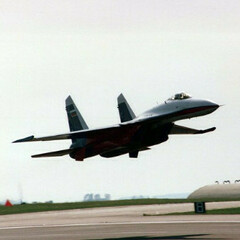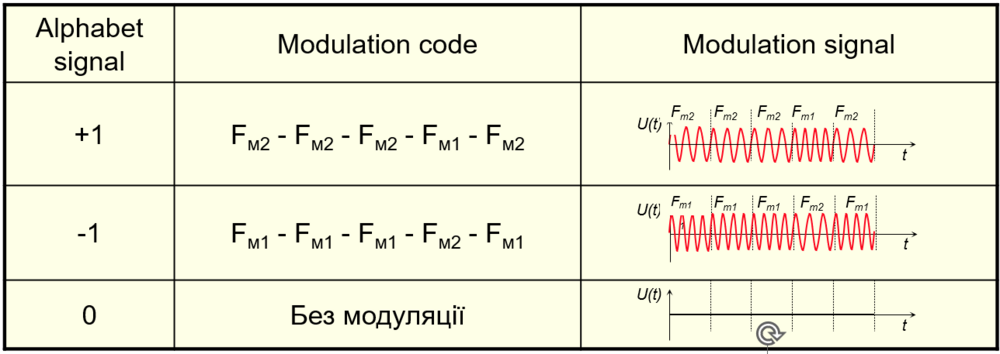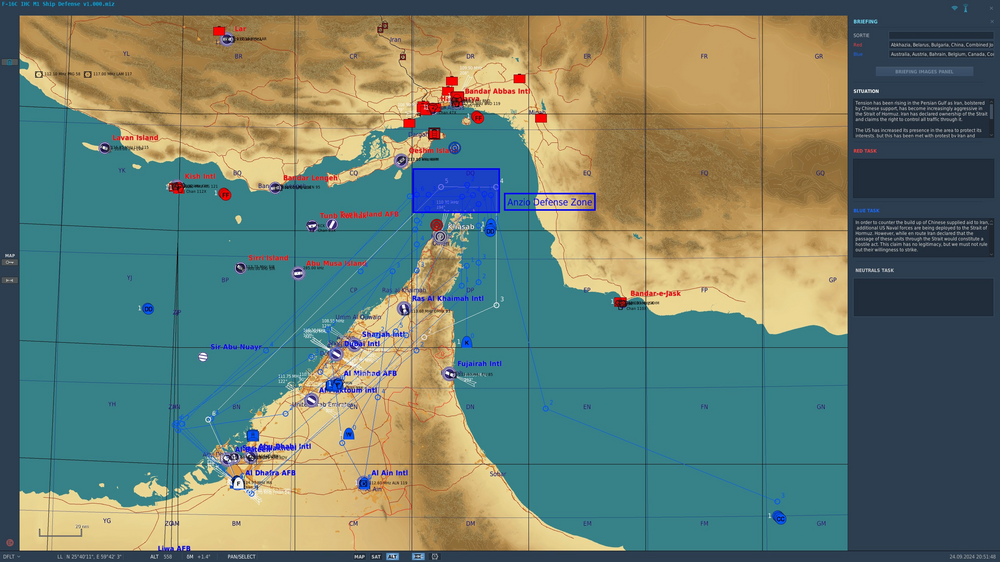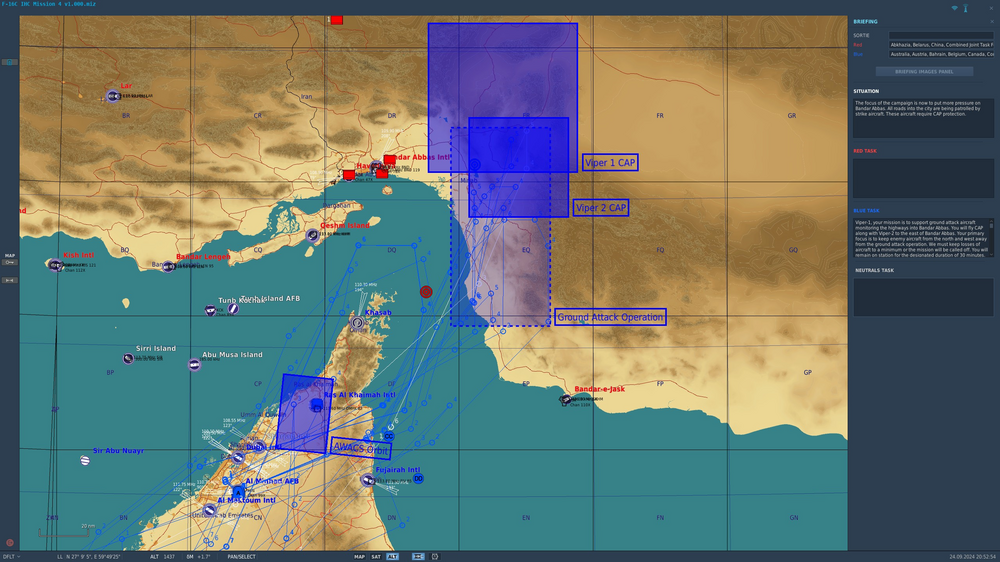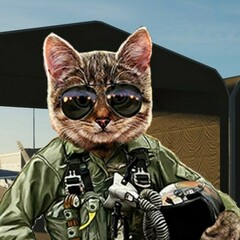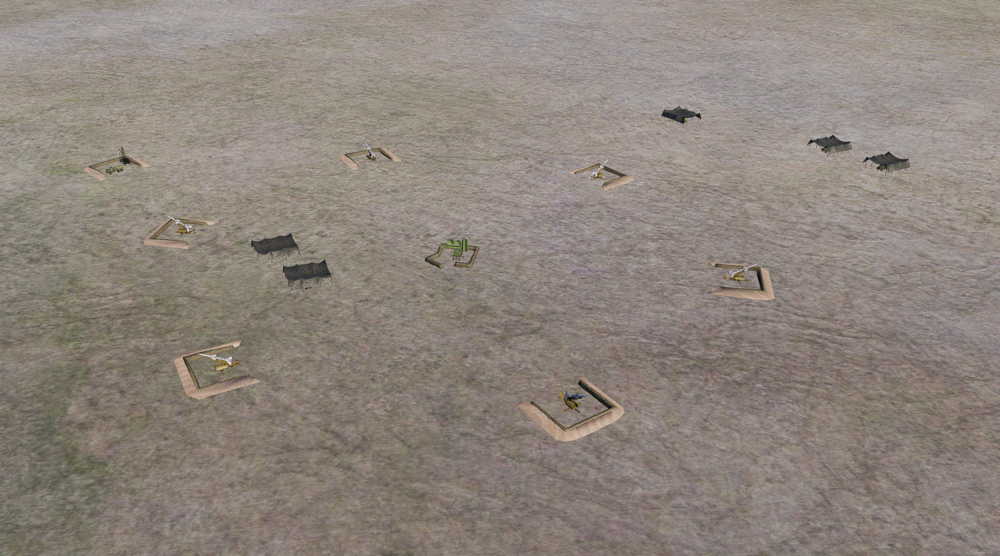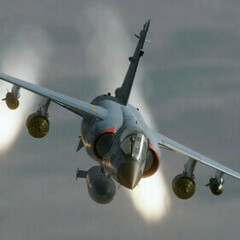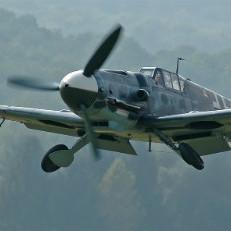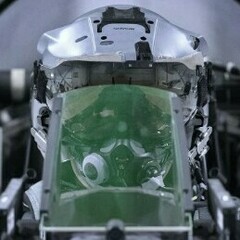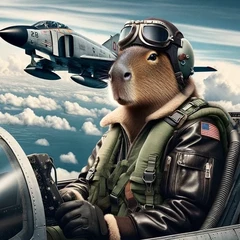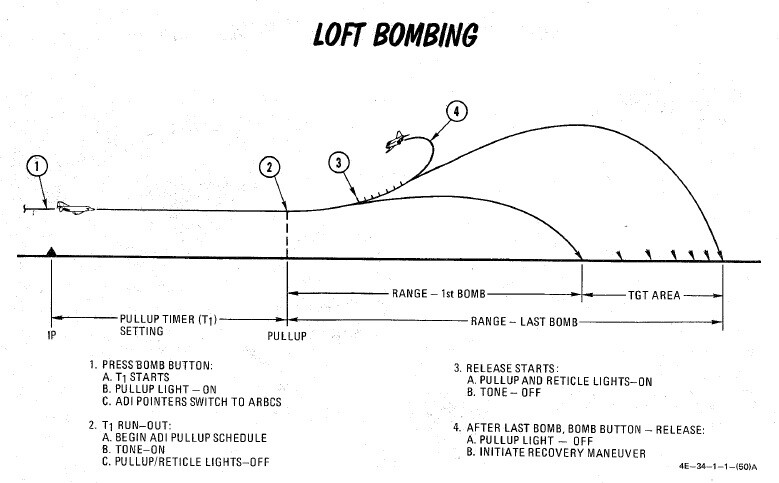Leaderboard
Popular Content
Showing content with the highest reputation on 09/29/24 in all areas
-
5 points
-
So FWIW, I just did a quick stress test, 2.5 minutes of full force deflection before force started to drop (according to the Moza software), it was another minute before I could actually feel a difference in the force.5 points
-
You already did much and even helped making some DCS missiles better when devs took your advices and help ex. for the HARM FM so it is appreaciated and a tribute for yourself. I even learned literal rocket science from you, thanks Now about math in simulations - it's only good up to a point because it takes CPU time. Coders sometimes have to avoid too much math because of this. They make tables or roundings wherever possible and applicable instead. Having said that I always prefer more realistic representation whenever feasible. As we learned HB men like to go back and update their work with new ideas and info when they have time so it's possible we may see some improvement in the future, although the new missile guidance, behavior and "API" is much more needed for Phoenix right now.4 points
-
No need for a detailed report. It's bad the company knows its bad, the community knows its bad and continues to try and make support for it yet you can't seem to understand that. You want detailed reports like you're relevant to the matter or while having no real constructive thing to say3 points
-
3 points
-
Here a 360° Eurofighter cockpit video where we can see how the pilots head moves during turns3 points
-
Watching the final flight pass over was something special. My son was there with me. I will miss the pretty silhouette of the viper in our skies.3 points
-
General information about RTS missile control Purpose, composition and principles of construction A radio control system (SRU) is a complex of functionally connected radio technical and other technical means, designed for automatic or semi-automatic control of an object (aircraft, missile) with the aim of bringing it to a given point or to a given position relative to another object in action destabilizing factors. The information subsystem issues signals of missile deviation from the desired trajectory. The sources of information are radars, IR direction finders, other means of obtaining information about the target, radio technical information transmission systems, sensors of the parameters of the missile flight, the state of the missile and its subsystems, etc.. By processing the information with the appropriate algorithms of the computer (analog or digital), the deviation signal (SV ) rockets from the desired trajectory. The control subsystem (missile control system - SUR) directly affects the missile control bodies (on the control object) in accordance with the SV to eliminate guidance errors. During automatic missile control, the information subsystem equipment is located on the missile. In case of non-automatic control with the participation of the operator, the equipment of the information subsystem is placed on the rocket and on the rocket carrier. The trajectory control signal generator (FSTU) provides the operator with information about the deviation of the missile from the desired trajectory by analyzing information about the relative position of the missile and the target. Based on this information, the operator adjusts the missile's flight using the control command generator (CCM). Control commands are transmitted to the missile through the command radio control line (CRC). Destabilizing factors lead to deviation of the rocket from the desired trajectory and flight profile. The missile control system (MSC) detects these deviations and produces control parameters ΔГ and ΔВ in the horizontal and vertical planes, which ensure the elimination of these deviations. The deviation of the missile from the desired trajectory or flight profile is monitored by the information system of the missile or its carrier and is used to issue control commands that keep the missile on a given trajectory. During normal operation of the SUR Δ ≈ 0. In autonomous SUR, the control parameter Δ is formed by comparing the programmed (set) parameters of the rocket’s own movement (position) with the actual ones, which are controlled with the help of on-board information systems - gyroscopic, inertial, astronavigation, Doppler, radar, radionavigation, television, radio astronomy, barometric, control according to guidelines and others. Autonomous SUDs are used to control missiles in order to impress stationary targets with known coordinates, as well as during the first stage of the missile's flight immediately after its launch to impress moving targets in non-autonomous and combined SUDs. In the latter case, thanks to the use of an autonomous air defense system at the first stage of its flight, the possible range of missile launches is significantly increased. In non-autonomous SUR, the information received from the target (homing system) or from the control point (command radio control system, radio zone control system) is used to form the control parameter Δ. In homing systems, missile control commands are formed based on the analysis of signals coming from the target - optical, infrared, radar, and the target's own radiation. Radar homing systems can be active, semi-active or passive. In command control systems, the corresponding commands are formed on the carrier and transmitted to the missile via the command radio line. The measuring equipment of the information subsystem is placed completely on the carrier or partially on the rocket (for example, a television camera) and on the carrier. In radio zone control systems, the carrier equipment creates a radio zone that sets the trajectory of the missile. The on-board equipment of the missile determines the current deviation of the missile from the axis of the radio zone for the formation of control commands. Non-autonomous anti-missile systems are used to control missiles when hitting moving and stationary targets. In combined SUR, both methods of obtaining and using information are used to form the control parameter Δ. Combined missile control systems by using the most rational control system at each stage of the missile's flight ensure the maximum quality of missile control and a long launch range. For example, targeting a long-range missile is carried out first according to the program, then by semi-active homing and finally by active homing. In the pulse radiation radar, the illumination signal of the on-board fighter radar of the fP+FD frequency reflected by the target is followed in direction by the missile coordinator - the control parameter φ is determined or the additional selection of the target by range is carried out by comparing the moments of reception of the direct (tail antenna) and reflected (nose antenna) illumination signals. In the radar of quasi-continuous radiation, reflected signals are selected by speed by comparing the frequencies of direct (tail antenna) and reflected (nose antenna) illumination signals. Modern missile coordinators are monopulse tracking direction finders. Thanks to this: the coordinator is insensitive to amplitude-modulated interference created by the target; high accuracy of bearing is ensured. Target selection by range or speed of approach during pulsed radiation is carried out by range or speed tracking systems. On launch, the homing head (GOS) against the background of powerful signals from the aircraft's on-board radar transmitter cannot receive weak reflected signals. Therefore, only after launching the GOS to detect the attacked target, it searches for it. In order to avoid errors (when the target is not the same) and to speed up the start of homing, the target indication by angular coordinates and speed (range) is issued and memorized on the suspension in the GPS. After launching the missile, the target can change its flight parameters. Therefore, a special radio correction channel is introduced to transmit changes in target parameters to the missile. For coordinators, errors such as angular noise are characteristic, which are the result of the fact that when approaching the target, its angular dimensions increase and the target is no longer perceived as a point. This is taken into account by the missile control system algorithm. Advantages of semi-active GOS: long range of action with small size and weight; independence from weather conditions and the target's own radiation; the possibility of additional selection by speed (distance); the possibility of correcting the parameters of the missile control channel after its launch. Disadvantages of semi-active GOS: the need to illuminate the target until the moment of its impression; the possibility of creating interference on the reference signal channel (radio correction); the complexity of the rocket equipment. The passive GOS coordinator accompanies the target by its own (thermal) radiation or by the radiation of the radio-electronic equipment of the target. Powerful thermal infrared (IR) radiation in the range of 1.8 ... 6 μm is created by the power plants of airplanes and helicopters mainly in their rear hemisphere (ZNS). The high spatial selection and sensitivity of thermal homing heads (TSH) allow to identify and track the target in its runway even before launch. After launch, such a passive missile homing system operates autonomously. Passive radar homing heads (PRGS) are used in air-to-air missiles to impress emitting radio-electronic objects (RADS). As in the TGS, targeting, detection and capture of the target for tracking is carried out before the launch of the missile. The launch is carried out when the permitted launch range is reached. The starting moment is determined by indirect methods - by ground reference points with known coordinates of the object, by the basic or angular method with unknown coordinates. The flight of the rocket is carried out at a reference height. The moment of the start of diving on the target is determined upon reaching the calculated angle of elevation. 3. Command radio control systems The principle of operation of command systems Alignment of the control point (aircraft – missile carrier), target (biased point) and missile on the same straight line is provided by PU commands, which are generated based on the results of monitoring the current position of the missile relative to the given flight path. The control parameter is the angular ε or linear h deviation of the missile from the given trajectory. The angular deviation ε is controlled by the carrier's on-board equipment by tracking the directions to the target and the missile. Linear deviation is calculated: h=ε·D. The current range D of the missile is monitored by the range finder of the carrier or calculated: D=∫V(t)·dt or D≈VSer·t, where VSer and t are the average speed of the missile and its flight time after launch. The current value of the control parameter is transmitted to the missile via a radio telemetry line. A possible option is when the control parameter is calculated by the rocket equipment. In this case, the current results of monitoring the position of the missile and the target are transmitted to the missile via the telemetry line. The carrier receives information about the coordinates of the target εЦ, ДЦ and the missile εР, DR with the help of radar coordinates of the target (VKC) and the missile (VKR). VKTS is an active-type radar, and VKR is an active-response radar. The current coordinates of the target and the missile are used by the control parameter calculator (ОбчΔ) to determine the missile control parameter. The current value of the control parameter and other information in the control command generator (CCM) are converted into control commands. The transmitting part of the multi-channel command radio control line (KRU) transmits these commands on the operating frequency. From the received radio signal, the receiving part of the missile control unit issues control commands for the missile control system (MSC). The encoder (Ш) and decoder (ДШ) of the switchgear are means of protection against interference. The command radio control system of the fighter In the weapon control systems of modern fighter jets, command radio control of missiles after their launch is used to correct missile control algorithms at the stage from missile launch to the start of target tracking with missile homing heads. Control commands are formed and transmitted over the target illumination radio channel by semi-active radar homing missiles. A base-3 code is sometimes used to transmit air-to-air missile control commands; its alphabet consists of the symbols "-1", "0" and "+1". Codes with a base of 2 can be used to encode the signals of each of the three symbols, for example, the 5-bit code 1-1-1-0-1. In the ternary system, a “direct” code is used, that is, the sequence of symbols 1-1-1-0-1, a “reverse” code, which is an inversion of the direct code, that is, a sequence of symbols 0-0-0-1-0, and the so-called “ "zero" code, in which there is no coding of primary signals. If frequency modulation of the signal with frequencies Fm1 and Fm2, which correspond to elementary binary symbols "0" and "1" of the code, is used for coding, then signals according to the table will correspond to each of the three symbols of the alphabet. With two-digit words in the triple number system, it is possible, for example, to convey the set of six corrections given in the table with a value that is a multiple of of some of the missile control parameters. The remaining codes (-1; +1) and (+1; -1) can be used to transmit two more one-time commands. This is very detailed!3 points
-
I'm optimistically hoping that we're going to see 'better than ST' performances for the first time with MT. IIRC, the best performance I've seen for ground units was back in 2.5 - when it was single thread only. Since then, MT was introduced, but performance has gone backwards. My best 'guess' is that the way MT has been implemented has created some bottle necks with thread sync that is causing worse performance. Once these issues are resolved (hopefully in the next update) - I would expect us to have at least the same performance we once did...but possibly even better if we actually start getting the benefits of multithreading with AI calculations. The picture in my mind is like a river has been widened with MT, but a wall has inadvertently blocked part of the river, creating a DAM behind it, and there's a huge amount of 'extra flow' just waiting to be released as soon as that bottleneck/dam wall can be destroyed. IDK whether ground units / AI calculations (especially but not limited to radar and pathing) are done in their own threads, but I'm hoping that they are - and that we could see thousands of units on a map again, with better performance than we saw in 2.5. Whatever is done though, I certainly don't want to see a repeat of the previous update - where it felt a lot more like the first of "Open Beta release" for a particular version, than it does a stable release. With only one public version now - we need each version to be as stable as possible - especially considering that fixes for any problems introduced are now 6+ weeks away in the next build.3 points
-
This is how it was for so many years before and it was one of the longest running complaints the sim had, especially because it was the only sim on the market which did literally nothing to make the visibility of aircraft more realistic. It was awful and I don't want to go back. Dots are flawed, and not remotely my ideal solution, but it's better than nothing.3 points
-
A lot of my assets would probably still work with older DCS versions. But since I more or less need to update broken assets with every DCS version chances are a lot of them won't work as intended. For this reason I only support the latest version. There are too many changes with each DCS version to be able to support multiple versions.3 points
-
After much time I've finally completed my first campaign. Please leave feedback here. Current status - available on user files https://www.digitalcombatsimulator.com/en/files/3340795/ PLEASE LEAVE ALL FEEDBACK IN THIS THREAD, USER FILE MESSAGES ARE UNLIKELY TO BE READ An air to air campaign for the F-16CM Blk 50 where the player flies for the USAF, set in the Hormuz Strait region in the year 2010. This campaign features missions with elements of randomization for replayability and mission uncertainty. The experience is intended to resemble that of a pilot in combat in that the missions will go on with or without the player's success, with some exceptions and within the limits of the DCS Campaign system. Missions will feel similar to my previous stand alone missions. The campaign is not strictly historically accurate, but attempts to be within the realm of plausibility, though mission content was given priority over world building. The campaign may be thought of as a mission pack rather than a narrative. Players should be familiar with the F-16 including startup, takeoff, navigation, communications, systems management, fuel management, weapon employment, and landing. Air to air refueling is present but is not strictly necessary, however some missions may push the limits of range without use of tankers. Wingmen are an important component of the campaign. Familiarity with the wingman menu is recommended. Plan your approach based on the mission briefing and use the mission planner to give your wingmen preplanned actions before getting into combat. Understanding the commands to have your flight orbit and engage missions will be helpful in completing objectives. Missions are not instant action style and feature ingress and egress with total mission times up to 2-3 hours, with an average length closer to 1-2 hours. Briefings and the mission planner screen should provide relevant information and should be read before flying, again similar to past individual missions. Hard coding of objectives is avoided as much as possible and triggers are designed to be lenient to avoid situations where the mission breaks due to a particular action. The map mode is set to Fog of War. DCS AWACS performance is limited in some ways so I have set the F10 map to make up for this. Use the F10 map to supplement AWACS calls. As mentioned above the campaign is air to air focused and the player is not tasked with air to ground missions, but the jump feature can be used to jump into ground attack F-16's (and other planes) if desired. Beware that currently your original plane will immediately abandon its mission if you jump into a new plane. This is my first attempt at making a campaign and was also a learning experience as a result. While I have learned a lot, I was not able to apply everything learned to this campaign as I built it. Any feedback is welcome. Campaign requirements: F-16CM Blk 50 aircraft module Persian Gulf map module mods - none Sample mission planner images: Change log 11/2/2024 Scoring overhaul, it should no longer be possible to get stuck on some stages 10/24/2024 Second correction to mission scoring 10/13/2024 Corrected Mission 3B scoring and briefing, no other bugs found but occasional testing will continue Known bugs 10/5/2024 Mission 3B awards 50 points maximum, can only end in a draw > points scheme to be updated, skip button can be used as workaround for now2 points
-
Your hundreds of posts are also not helpful. You see a video analyzing the problem and the only thing you notice is the size of the dots. Go to a coldwar server, fly for 2 hours and you will see what the spotting problem means. I recommend spending more time in the cockpit than on the forum A game without text ERW refreshed every few seconds is basically unplayable This is incredibly realistic...2 points
-
Awh bless, It should be me apologising, my post was directed at someone else who appeared to me spreading mis-information, not just about 'miles' but his (assumption) understanding of consumer rights and end user agreements. Anyway, it's a horrible situation but I see you are not going to be dragged down the rabbit hole. Best wishes. Mizzy2 points
-
It's had years of supporting data in the form of videos and screenshots. WT had/has this issue for as long as I can remember as well, Play low res/graphics for some sort of tactical advantage, low res incentivized with low graphics blah blah. There is an incredibly unrealistic expectation of being able to see a 10x10 (exaggerating ofc) 20nm away. But having flown like many many others within DCS. There is no comparison to RL like the ignorant statement above claims.2 points
-
ED are not refunding in 'miles', they are refunding as a store credit to the same value as the module. If you read the opening post in the thread about this situation, you will learn what the situation is, rather than giving mis-information that only fuels more confusion. I hope this helps. A quick sidenote: If you bought the module through 'Steam', then there is no refund, it's only refundable if you bought the module through ED Store.2 points
-
ED has added three Towing tractor heads to DCS editor but missing the propper trailers: Refueler ATZ-60 Tractor Refueler TZ-22 Tractor S-75 Tractor The towing GUI has pressent on mission editor as Attach and Detach order on Waypoints.2 points
-
Great idea, ED please add these radars as a usable unit. SAM functionality its totally abandoned. They focus in moddeling explosion blast to move vegetation over real important things.2 points
-
2 points
-
Partly, there are both internal and external factors that led us to review both FMs and FCSs. While not as deep, the F-16C continues to have refinements. thank you2 points
-
2 points
-
Unzoomed, you are not looking at a "realistic" presentation. The first level of zoom is actually much closer to real world vision. So unzoomed and unscaled is not presenting objects as they would appear in reality. In VR, because of poor lighting, objects between 2-5 miles will disappear completely in the completely "realistic" DCS, better than real world visuals. Its weird that I never saw an airplane invoke this cloak of invisibility in my 30 years of professional flight. If DCS had proper lighting, the claim that "The game already provides better visuals than RL" would seem less ridiculous.2 points
-
I actually like OneDrive on its basic cloud storage function, but having Microsoft force it onto a User by moving important folders without having the user express agreement is reprehensible.2 points
-
2 points
-
2 points
-
You're not running Powershell 7.x It's called out in the error message.2 points
-
The spotting is incredibly bad in this game. i think its more so bad in the sense of a competitive state, You have to be playing in 1080p. If not, you get weird rendering of "dots" both in VR & flat, disappearing/appearing while zooming in/out. I've been in the sky many many times & they most certainly do not provide a better visual than RL, Unless you have poor vision. Scaling is incredibly important for anyone wanting to play above 1080p only because there doesn't seem to be any other viable solution.2 points
-
Totally fine to give your opinion @Tank50us, but these wild assumptions, based on.. well.. absolutely nothing.. are super annoying. My 2 cents on the subject: Current pilot body models are just fine for me. As long as I have virtual body, legs and arms, it good for me2 points
-
2 points
-
2 points
-
not sure about 2.9.3 but I’m still playing in version 2.9.4 with all the Currenthill pre-update packs for 2.9.5 (US, UKR, RU, CN). I only downloaded the new Germany and UK packs, and both work perfectly in 2.9.4, but only the case ejection not work in 2.9.42 points
-
There's two main issues in play here. 1. Most players don't play with the pilot body turned on so that they can see the controls and switches they need to. 2. The required amount of work to make a single character model is already tough enough when you consider the level of detail players demand (to the point where you can count the stitches on the uniform), rigging of the model, and the animations. And this would have to be done for every possible variation demanded. One other factor in play is the fact that you barely see the aircraft you're shooting at, and you're not flying close enough in formation with another plane to see their pilots that well. This all being said, would I like to see it? Sure. But compared to the laundry list of other things that the game needs.... this is pretty low on the priority list.2 points
-
You can’t separate the two of those. I’m sure most players want both i.e. realistic visuals. A game today isn’t going to put the work in on all the graphics and modeling only then to give you giant sized aircraft hanging over an undersized carrier deck. Just not going to happen. I’m not referring to just a varied FOV setting but doing this on the fly as in the zoom view. That’s the better solution all these sims use now. Just make everything you see bigger equally as needed instead of just the target. That eliminates the need for smart scaling altogether.2 points
-
as a preflare definitely has an effect. but of course i have to say that it would also be nice if you could see the influence of flares in the HUD. I have just done a rough test and it also makes a difference if you drop the flares towards the missile so that the flares fill the FOV of the seeker better. A10 Preflare: https://streamable.com/90pete Stinger : https://streamable.com/k1fufc flare.acmi EDIT: I have to say it's quite constant, if you drop the flare from the beginning towards the missile seeker a couple are enough, but if not I need a whole bunch.2 points
-
Bro, I literally posted a link showing updated smart scaling adjust for varying FOV. I get you dislike it but please read up before just saying it doesn't work. Every modeling approach has issues and requires compromises, but at least bring up issues that are actually issues. Modern approaches to smart scaling do adjust for varying FOV. So if that's your concern you can relax. People have worked beyond the original Serfoss paper. And it's not a waste, imo, ED have changed their mind on big things before, my goal is simply to advocate for realism over visuals (and you are of course free to do the opposite).2 points
-
The official line from Wags and 9L has always been that this would interfere with radar RCS calculations, which is not an explanation I buy but that's what they've said for years. The straight from the horse's mouth answer is that such a solution is "heresy" because spotting in DCS is already excellent and better than real life. If you have a problem with that, you should buy a 4k monitor that is at least 32 inches big, preferably 40. The problem is clearly because of your hardware, and you should just turn on labels and zoom in if you don't want to buy a very large and high resolution monitor.2 points
-
Here’s 78 pages on why scaling is necessary in simulation to replicate the same visual cues pilots rely on in BFM. https://apps.dtic.mil/sti/citations/ADA414893 But we can’t have that or dots or anything that might benefit anyone with any actual BFM skill. All kills must be from an unseen adversary because “realism”.2 points
-
I certainly won't disagree with the last paragraph (flight sim genre nose dived after 2002, until Covid). But those are certainly not just rumours. And what actual facts contradicting? Immersion was until recently the patent holder for nearly all things FFB, haptic and touch feedback (see here, and here as well). They're know to be quite strict and have sued quite the number of companies, if you look into that part of their history, including Sony in 2002, Apple in 2016 and Valve in 2023. When Immersion sued Microsoft in 2002, Microsoft settled by buying 10% of Immersion Corporation (which, I think, is why some of the patents has Microsoft listed as the patent holder). Of course the license fees exhist and deals can be struck - that's part of their business - but it doesn't mean such deals are frugal. The opposite is actually considered to be the truth, because even one of the big companies in the console market decided to not license - actually ditched the tech - for one of their most antecipated products (Sony did not feature touch-feedback technology in its pack-in controller for the PlayStation 3). Logitech had to license their G940 FFB stick when it released in 2009 ("I-FORCE™ Force Feedback Technology Licensed from Immersion Corporation"). But that's a huge multi-million company that could afford to risk it, and went for it (at the wrong time of flight-simming, should be said, and why it flopped). Thrustmasters, and Saitek (now property of Logitech), didn't go for it, and they certainly had the means and expertise. Perhaps conjuncture - too costly to develop and produce for a small market, and then the Immersion licensing fee on top made those a no go. How did that went for Brunner, VPForce and FFBeast I don't know, nor do you. But I can't believe (do you?) that a licensing deal with Immersion is so affordable that it wouldn't impact those smaller companies resources, or that it wouldn't impact on the final cost of already expensive boutique products, to sell on a niche market. Three of the important patents were listed as expired around 2021 (last time I went around this subject, that link was working), so I understand that both the acronym and the “haptic” simulation of software to an engine can be done without paying this company. Adding to that, the flight sim market has reemerged (exploded is more correct) around that time, and it's still growing. So, I don't think it's wrong or "rumour" to say that it's one less (considerable?) barrier to produce force feedback stick options, that are finally reappearing and probably will multiply in the coming years.2 points
-
Thank you all for the feedbacks ! I've been in the military lately in the Swiss air force officier school. We just finished the mountain course this week. Because of that I haven't had much time for DCS unfortunately... I will have a month off in december so I'll try to correct the liveries then. If I forget don't hesitate to remind me here. cheers !2 points
-
It would be great if ED's "SME's" could be active on the forums or public channels and actually explain and show why they think the DCS Viper behavior is right. Would love to see it. Simply saying "trust us" is far from scientific and is never considered as an argument or proof for any bug report. Considering the many FM reworks and improvements this only proves that the FM was far freom ideal on release and in the first years of EA. Seen several SME's, some more active and known ones like Mover, who said that the DCS Viper is pretty off in some regimes of the envelope. Just modeling the Ps0 line is far from enough for a flight model. SEP across the envelope as well as the correct moments across all axes are way more important.2 points
-
Already have employment, this is just a hobby and interest of mine. There is no enough math, never been, math is all around us. Tell me please, what do you think, do you have in this simulation correctly modeled Phoenix in mechanical point of view? This second sentence of yours is very worrying. Looks like situations in corrupted states where if you are not member of ruling political party you can bark all days long and nothing will change Just joking, now honestly, like said it doesn’t bother me at all if anything get changed or not. But if I manage to make, at least few to get interested in all this and to start asking questions and perhaps express doubts, the goal is done. Once I said here, flood on internet of wrong information about Phoenix is coming mostly from DCS and WT. And I stand by that, simply, I don’t know terminology for that, but googling commonly sends you to related pages and then it is to late So, math will continue , maybe guys from HB, or HB is a guy, I don’t know, will join us in this conversation, who knows. Stay well all of you2 points
-
Any new updates on the WW2 Marianas island map? Any information about new map additions to Afghanistan map? Mike Force Team2 points
-
FWIW, the Russian SK manual that’s floating around refers to that line as “Time, remaining until missile meets the target.”2 points
-
Hopefully the Marianas map will get performance improvements. Thank You!2 points
-
So you would like to shoot the AGM-45 Shrike off of your shiny new Phantom and LARP that you are an F-4G or a Wild Weasel of yore. The first thing thats probably on your mind after playing around with it is probably “this missile is broken” and “how the hell does it work even”. Hopefully this guide can help clear up some of the confusion about the original Wild Weasel anti-radiation weapon and help you figure out how to use it in DCS. How the AGM-45 guides Everybody is probably wondering about the new seekerheads you can select with the arming and rearming menu, but first lets start with the basics. How does the AGM-45 actually fly to its target. “Its just an ARM” you say, “if it sees the emission of its target it should guide on it.” Yes and no. There are several things that have to occur for the shrike to guide. Lets start with an overview of the Shrike itself. The seeker The seeker is a passive Radio Frequency seeker that has a 45 degree field of view in DCS and a 150 second operating time, the seeker is on once the shrike is armed and will give you a high pitched tone, similar to a sidewinder, that indicates when it is tracking something inside its field of view. This tone may stutter or change as the emitter that the seeker is tracking rotates or changes modes. Once launched the seeker is always tracking or attempting to track something that it can see within its field of view. Guidance control The guidance control section is the “autopilot” that gives the commands from the seeker to the fins to steer the missile. This section is not enabled until after launch and certain conditions are met. You can choose the conditions that will enable the guidance control by selecting LOFT ATTACK or DIRECT ATTACK on the rearm fuze selection menu, or in the mission editor. You cannot change these via switchology in the jet (there is an exception but it is not implemented yet. If this changes I will update this to represent this) LOFT ATTACK: This is the most complex set of conditions to enable the guidance control section. The conditions are: Missiles barometric altimeter detects a pressure increase of 1 PSI (~1-3000 feet depending on altitude and temperature) Missiles barometric altimeter sense that the missile is below 18,000ft MSL ONCE BOTH OF THESE CONDITIONS ARE MET THE GUIDANCE CONTROL SECTION WILL UNLOCK and the signals from the seeker will be sent to the control section and the fins. Until these conditions are met the missile will be flying completely ballistic and unguided, even though the seeker may see and be tracking the emitter the entire time. DIRECT ATTACK: With this selected the altitude sensor for the loft attack is bypassed and the guidance control unlocks approximately 3 seconds after launch. This is your “shoot it straight down the throat” guidance control selection. The AGM-45 will naturally roll at approximately 55-60 degrees per second, and the guidance control system does not attempt to stop this once it enables. Additionally the fins only actuate with BANG-BANG control inputs, which you can watch if you observe the missile via F6 after launch. All of this is to say that once the guidance enables the AGM-45 will be corkscrewing and its fins will be BANG-BANGing constantly, which results in a very high potential energy loss once guidance begins. What all this means for employment and range DIRECT ATTACK guidance missiles will have VERY short range, and the depression angle is very important, the more the missile has to glide to the target, the more likely it will just run out of energy and fall extremely short. Recommend trying to fire by getting 20 degrees or more nose down pointed straight at the target, or being right on top of it if firing at low altitude. Both of these will result in very short ranges. LOFT ATTACK guidance however can get quite good range if lofted accurately. The fins remaining locked and the missile flying ballistic until guidance enable allow it to retain much of its energy and usually results in a fairly steep (30-45 degree) descent angle when it enables guidance. However remember that the seeker only has a 45 degree field of view, and the target must be inside that field of view when the guidance section activates (below 18,000 feet and missiles altimeter detects a 1 PSI pressure increase). This means you have to actually get that missile quite accurately to a window above the target when the seeker activates where it can detect it and guide. You can employ a LOFT ATTACK shrike directly pointed at a target or level (not in a loft) as well, and it will get more range due to the fins staying locked for longer, however the missile will not start guiding till much later, so for short range immediate guidance scenarios it may not be the best. With all of that How do you shoot the Shrike in the F-4E Ok so you understand what the DIRECT and LOFT ATTACK modes do, and what the up and downsides of each mode are and what effect they have on the missiles guidance and energy. Now we get to how do you actually Use them in the F-4E. There are 3 modes you can use to employ Shrikes in the F-4E: LABS Loft WRCS Direct WRCS AGM-45 We will cover these three after going through the basic cockpit setup. Basic cockpit switch setup For all these modes you must: Select the station for the shrike(s) you wish to employ Select ARM on the weapon select knob Select one of the 3 modes on the LABS/WRCS knob (LOFT, DIRECT, or AGM-45) (optional) Turn the Flight Director on (if you want the needles on the ADI indicating shrike seeker look angle) (optional) select A/G on the Sight Turn Master ARM on LABS Loft Selecting LOFT on the LABS/WRCS knob will allow the LABS LOFT circuits to fire the shrike automatically. However this works Exactly Like it does for bombs, it simply applies the launch signal to the shrike launchers, instead of a release signal to bombs. So it is setup and used the exact same way. You will need to plan out an IP, a run in time to your loft point, and pick a loft angle, enter them in the LABS computer and timer in the backseat. Once these are entered, you then overfly the IP, hold the pickle button down, point at the target, and follow the ADI needles, as you rotate through the preset loft angle with the pickle button held down, after the expiration of the run in timer, the missile will depart the jet. This mode obviously requires preplanning, and the ability to know ballistically what angle you want to release the shrike at, and at what range to start the loft, and then use this to enter in the run in timer, select an IP and pick a loft angle. None of this is calculated for you, so only via trial and error and practice will you be able to figure out what settings will work for you. For more information about Loft you can also take a look at our manual: Lofting & Tossing WRCS DIRECT Selecting DIRECT on the LABS/WRCS knob makes the selected shrike launch approximately 1 second after you hit the pickle button. That's it. Center up the needles, or dont center up the needles, pickle and the shrike will go on its merry way. There is zero automation, so if you desire to fire the shrike in a loft, you will have to manually pull up based on your own practice and situational awareness. There is also no indication that you are in range or out of range. WRCS AGM-45 Selecting AGM-45 on the LABS/WRCS knob is the “preferred” way of employing the shrike, it will give you ranging indications for the shrike and let you know if you are in range to loft, perform a level release, or a diving release of the shrike. If you want to perform a loft or level release with this mode, you should be using a LOFT ATTACK shrike. The WRCS has no way of knowing which type of seeker guidance you have selected and will always be calculating assuming the LOFT ATTACK logic is occuring. Thus if you fire a DIRECT ATTACK missile following the loft or level release cues, it will probably start guiding immediately, and fall far far short of the target. WRCS AGM-45 makes use of the “target altitude” setting in the computer panel in the WSO cockpit to trigonometrically calculate a ground range to your INS depression angle as displayed on your ADI. Any time your nose is below the horizon it should be calculating the range to where the ADI depression intersects with the set target altitude, if you would like your reticle to match, you need to have it depressed by 35 mils. For the most accurate ranging you will want that target altitude set to a representative altitude of the theater or target area you are pointing at. One interesting use of this is even if you have no shrikes on the aircraft you can select this mode, and if you depress the reticle 35 mils, you can use this to get a range to locations on the ground by pointing at them with the reticle (assuming the target altitude setting is relatively accurate.) This range should be displayed on the range readout on the HSI any time the nose is below the horizon and the calculation is running. The max range this system can calculate out to is 30 miles. This is a limitation of the WRCS, it will not display a range greater than 30 miles. As soon as it calculates a ground range the WRCS will calculate if you are in range for a shrike and if you are in range for a loft, level, or diving release. Indication that you are in range will be one of your AOA indexer lights lighting up to indicate which of these deliveries are available to you. The indications you could get are: Out of range, no lights light up In range with a loft, upward pointing chevron illuminates In range for a level launch, donut illuminates In range for a diving direct launch, downward pointing chevron illuminates Remember these indications are based on your current nose depression angle, and will be calculated and displayed regardless of whether your shrike sees anything, or even if you have a shrike on the aircraft. Only one of these should turn on at any time until you pickle, once you pickle and hold the donut will eventually illuminate to inform you the launch is about to occur. Just to visualize this, if you start out of range to a threat, and fly towards it, with the nose pointed at the target (in a dive), first the loft cue (upward chevron) will illuminate as you get into range for a loft, then once you are close enough for a level launch, the upward chevron should go out and the donut should illuminate. Once you are too close for a level launch and approaching minimum range, the donut should go out, and the dive cue (downward chevron) should illuminate. If you get too close for that, then all the indexer lights should go out. To use the system, select a shrike and point towards a target, once you get a signal and the needles deflect, center up the needles, once you have the needles perfectly centered in your ADI, your ADI should be directly pointed at the targets location and assuming your target altitude in the rear cockpit is somewhat accurate, the calculated ground range and LAR should also be fairly accurate. You could also do this if you visually see a target SAM site or SAM launch, if you know the type and have the correct type of shrike seeker selected, with your reticle set to 35 mils (matching the ADI boresight) you can put the reticle on the target SAM to get your dip ranging as well. Once you have an in range indication (one of the AOA indexer lights has illuminated) with the ADI or depressed reticle centered on the target location. Pickle and hold as you maneuver for the release. Pickling will save the range calculated and start the release computation for the shrike. Remember to continue to hold the pickle button down as you fly the launch maneuver and until the missile leaves the jet, this can take several seconds. If you elect to do a loft with the upward chevron illuminated, pull up keeping the vertical needle centered while holding the pickle button, the donut will eventually illuminate to let you know that the missile will launch in 5 seconds assuming no parameters change. If you continue to pull up after the donut illuminates, it is possible for it to launch sooner than 5 seconds as the parameters are changing after the donut illuminates. If you elect to wait until the donut illuminates and perform a level release, simply hold the pickle button and pull to level, the donut should remain illuminated and within 5 seconds the missile should launch. If you wait until the dive cue is illuminated, keep the target centered in the ADI needles, pickle and hold, the donut should illuminate and the missile should launch within 5 seconds. The DF REJ switch on the center pedestal should remain in DF REJ (down), this uses the very accurate INS depression angle (requiring you to dip your nose to align the needles on the ADI) to calculate the range. NOT IMPLEMENTED CURRENTLY-DF REJ is always used regardless of switch position You can also move the switch to NORM (center position) This will then just use the raw shrike seeker depression angle in the same calculation, not requiring you to dip the aircraft's nose. However, the shrikes seeker depression angle is very inaccurate, and this will more than likely result in gross ranging errors which can result in your missile going too far or too short and never finding the target. NOT IMPLEMENTED CURRENTLY-DF REJ is always used regardless of switch position The recommendation from the real world manuals and how heatblur have modeled the shrike seeker indications in the cockpit is to leave the switch in DF REJ and perform the dip ranging maneuver before launch. Gotchas The LABS/WRCS knob has ZERO effect on whether the AGM-45 performs the LOFT ATTACK guidance enable logic or the DIRECT ATTACK guidance enable logic. This can be the source of much confusion. You could choose LOFT on the LABS/WRCS knob, and fire a DIRECT ATTACK shrike, it will then enable guidance 3 seconds after launch, and pull down out of its loft to track the target it sees. You could choose DIRECT on the LABS/WRCS knob and fire a LOFT ATTACK shrike, it will then follow the LOFT ATTACK guidance enable logic detailed above, enabling below 18,000 feet and after detecting enough of a descent. The other thing is there is very little actual automation or computation with either LABS LOFT, or WRCS DIRECT, you are essentially doing all of the planning or in range assessment yourself in these modes. Practice will be necessary and some trial and error to determine what altitudes, loft angles, and ranges will work. Seekers The following table will help you understand which seeker can sense which radar. The above table is confirmed guidance for various seekers. Thank you to Jusik for testing which seekers work. MK 37 for SA-3 is not confirmed by testing. Sources F-4E-34-1-1 1986/1995 F-4G-34-1-1 1985 AGM-45-7A SHRIKE. FINAL TEST REPORT McMaster; 1977 ( https://scholarworks.calstate.edu/downloads/th83m2998 ) https://www.youtube.com/watch?v=eqxfNAEkQo8 IRON HAND: Smashing the enemies air defenses, Thornborough; 2001 DCS weapons lua1 point
-
Your argument against a well thought out scaling solution is to argue that DCS already has scaling in the form of zoom? Classic And you very obviously did not read the paper or cannot comprehend what he wrote because it directly refutes your statements above. Also, all PhD's are Doctor of Philosophy. Its the name of the degree. It does not refer to the discipline in which the PhD is sought.1 point
-
27. September 2024 Liebe Piloten, Partner und Freunde! Der DCS-Sommerschlussverkauf 2024 endet am 30. September um 15:00 Uhr GMT. Dies ist eure letzte Chance, viel zu sparen und etwas ganz Besonderes mit nach Hause zu nehmen! Besucht unseren Shop. Das nächste DCS-Update befindet sich in der Testphase, und wir freuen uns darauf, es bald in eure Hände zu geben! Zusätzlich zu den Verbesserungen des DCS-Kerns, der F/A-18C und F-16C Viper, die letzte Woche vorgestellt wurden, wird es auch Verbesserungen für den CH-47F geben! Die Details dazu findet ihr weiter unten. Wenn ihr alleine oder mit einem Trupp auf einem Server fliegen möchtet, auf dem jeder Einsatz Auswirkungen auf das gesamte Kriegsgeschehen hat. Schließt euch den Shadow Reapers an und erlebt die Tiefe und Aufregung der dynamischen Kriegsführung in DCS! Vielen Dank für eure Leidenschaft und Unterstützung. Viele Grüße, Eagle Dynamics Sommerschlussverkauf Beeilt euch, die Angebote enden bald! Dies ist eure letzte Chance, vom Sommerschlussverkauf zu profitieren. Nutzt die Chance, einige Neuanschaffungen zu einem Bruchteil des Verkaufspreises zu ergattern! Unsere beliebtesten Module wie DCS: F/A-18C, F-16C und F-14A/B sind mit bis zu 35% Rabatt im Angebot. Karten wie DCS: Syria, DCS: Normandy 2.0 und DCS: South Atlantic sind ebenfalls mit unschlagbaren Rabatten erhältlich. Besucht jetzt unseren Shop! CH-47F Updates Seit dem Early Access unserer CH-47F hat das Team fleißig daran gearbeitet, neue Funktionen hinzuzufügen und bekannte Probleme zu beheben. Wir freuen uns darauf, die nächste Version von DCS zu veröffentlichen, die die folgenden Verbesserungen enthalten wird: Das Außenmodell wird mit neuen Bemalungen für Japan und die Türkei und verbesserten Pilotenmodellen verbessert werden. Im Cockpit wurden die Animationen des Steuerknüppels und des Schubhebels verbessert, die Piloten in der Egoperspektive hinzugefügt und die Spiegel- und Glasreflexionen korrigiert. Die Bordschützen werden ebenfalls Verbesserungen erfahren, mit der Hinzufügung des Rampenschützen, optionalen M240H-Maschinengewehren, der Hinzufügung eines Schützenkontrollfensters und korrigiertem KI-Schützenverhalten bei spielergesteuerten Hubschraubern. Eine Menge Arbeit wurde auch in die Avioniksysteme gesteckt, einige der bemerkenswerteren Änderungen beinhalten die Hinzufügung des ARC-164-Funkgeräts, richtige MFD-Startseiten, eine neue COMM-Seite über das SYST-Menü, Treibstoffanzeige auf der HSD-Seite, Funkfrequenzen und Vorwarn-/Hinweisfelder auf den MFD-Seiten, separater HSD-Zoom für jedes MFD, HSD-DME-, VOR-, TACAN-, VORTAC- und VOR/DME-Symbole, Referenzfehler, Geschwindigkeitsfelder und Windpfeil/Geschwindigkeitsanzeige auf dem HSD, Kurswinkel- und Spurwinkelanzeigen und mehr HSD-Ausrichtungsoptionen. Einige der Verbesserungen umfassen eine präzisere Flugplanlinie, die Größe der VSD-Systeme und die Farbe der Treibstoffanzeige basierend auf der Gesamttreibstoffmenge. Wir haben auch einige Fehler behoben, wie z. B. den Wert der Gesamttreibstoffmenge und andere Treibstoffanzeigen, die einfache Verwendung des Funkgeräts und mehr. Abgerundet werden die kommenden CH-47F-Änderungen durch die Unterstützung von Force-Feedback-Joysticks, eine Nachtsichtbrillen-Option für Bordschützen, eine verbesserte Lenkanimation und die Behebung des Einfrierens im Mehrspieler-Modus. Parallel dazu, aber noch nicht bereit für das nächste Update, wird weiterhin intensiv am Digital Advanced Flight Control System (DAFCS) und Longitudinal Cyclic Trim (LCT) gearbeitet. Shadow Reapers Mehrspieler-Server Wir stellen die Shadow-Reapers-Kampagne vor, eine der immersivsten und innovativsten DCS-Erfahrungen, die es gibt. Mit PvE- und PvPvE-Servern, die auf den Karten Syrien und Kaukasus angesiedelt sind, bietet diese Kampagne für jeden etwas. Wählt zwischen modernen PvE-Missionen, einem aufregenden 80er-Jahre-PvPvE-Server oder taucht ein in eine herausfordernde Hardcore 60er-Jahre-PvPvE-Kampagne. Das Besondere an dieser Kampagne ist, dass der Beitrag eines jeden Spielers zählt. Vom Abschließen von Missionen bis hin zum Ausschalten feindlicher Truppen wirken sich eure Handlungen direkt auf das Moralsystem aus, das das Blatt im Kampf wenden kann. Das hochkomplexe Zonensystem der Kampagne umfasst Versorgungslinien, Stromnetze und Ressourcenmanagement, was strategische Entscheidungen unabdingbar macht. Mit dem Missionssystem könnt ihr und eure Freunde Trupps bilden und eine Vielzahl von Missionstypen in Angriff nehmen, darunter CAP (Kampfflugzeugpatrouille), CAS (Luftnahunterstützung), Luftschlag, SEAD (Unterdrückung feindlicher Flugabwehr), DEAD (Zerstörung feindlicher Flugabwehr), BAI (Gefechtsfeld-Luftverteidigung) und viele mehr. Mit völlig zufälligen und unvorhersehbaren Missionen ist keine Kampagne wie die andere. Tretet dem Shadow Reapers Discord bei! Abermals vielen Dank für eure Leidenschaft und Unterstützung. Viele Grüße, Eagle Dynamics1 point
-
@MagicSlave Correct. When the LCTs drive to ground, the rotor heads tip forward like a traditional helo putting forward cyclic in. This helps with 4 wheel taxi, to give some inherent forward thrust while taxiing. So in the two wheel landing scenario, with LCTs in auto, you can anticipate needing a bit of aft cyclic to maintain the same pitch attitude, when they drive to ground. Often times in auto the LCT will cycle between ground and retract, even with 2 inches of aft cyclic, in which case you can pitch the nose up just by adding a touch of thrust (collective), as your back wheels are a pivot point. I highly recommended to trainees to use manual, mainly because of that accident. The only drawback to placing them in manual is the possibility the crew might forget upon departure, reach a fast cruise speed, unwittingly placing serious stresses to the rotor system. It's a maneuver that looks tricky, but really isn't all that difficult unless your cockpit is overhanging a huge drop off. We get lots of practice hovering with the Nonrated crewmembers giving us directions, so it's no more difficult than a sling load hookup or precision hovering task. It's actually easier once the back two wheels are firmly planted. The craziest one I ever did was in Korea where we sat on a maybe 15 meter clearing high up near the peak of a small mountain. The Koreans had saws and yard tools to de-vegetate an unmanned mountain EW outpost. So a tree covered mountain where they had lopped off just enough trees to get the back of a chinook in. I think we were there a good 10 to 15 minutes while they unloaded.1 point
-
1 point
-
Recently Browsing 0 members
- No registered users viewing this page.


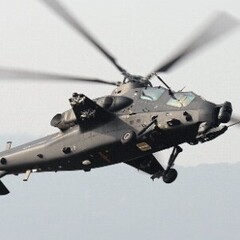


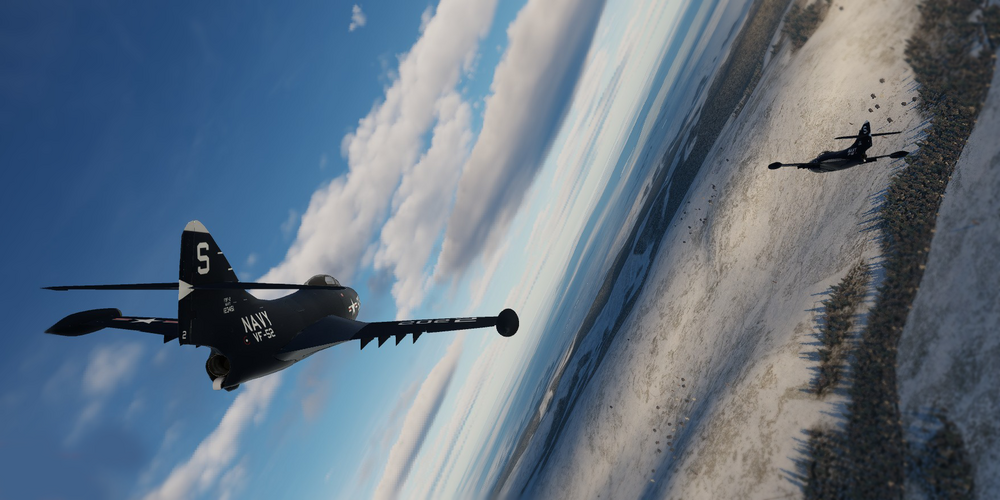
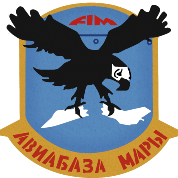
.thumb.jpg.fc0b9cafd75b2626adb73fdac664022a.jpg)

.thumb.jpg.4e1364f5c147f885cbea69ae1aa3e149.jpg)
